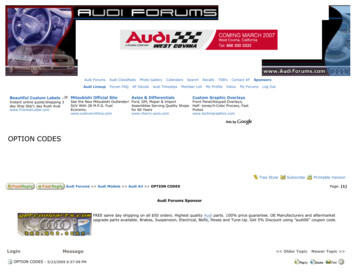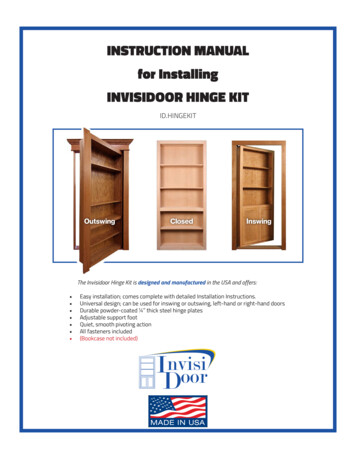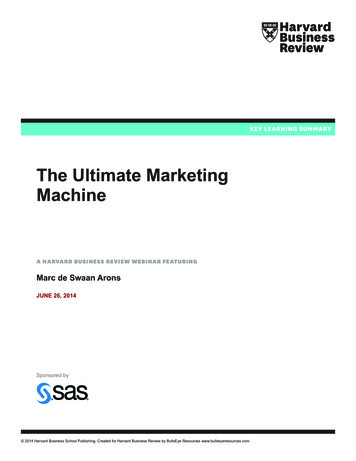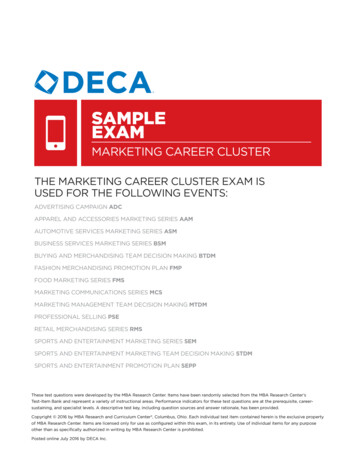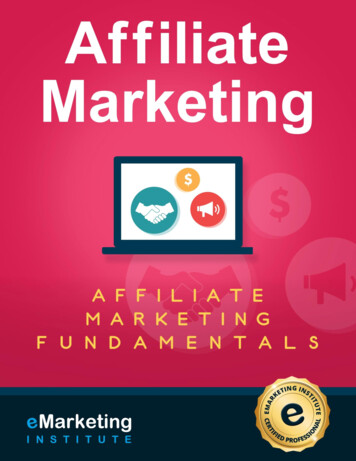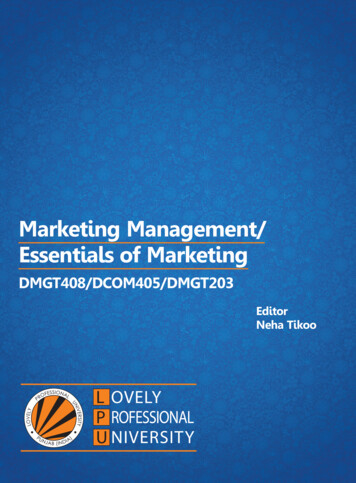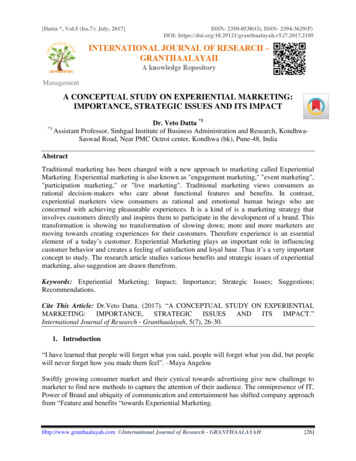
Transcription
DifferentiationGuidefor ProfessionalServices FirmsSecond Edition
Differentiation Guide for Professional Services Firms, Second EditionCopyright 2018Published by Hinge1851 Alexander Bell Drive, Suite 350Reston, Virginia 20191All rights reserved. Except as permitted under U.S. Copyright Act of 1976, no part ofthis publication may be reproduced, distributed, or transmitted in any form or by anymeans, or stored in a database or retrieval system, without the prior written permissionof the publisher.Design by Hinge.Visit our website at www.hingemarketing.comDifferentiation Guide2
Table of Contents4Introduction5Chapter 1Understanding Differentiation for Professional Services10Chapter 221 Ways of Looking at a Differentiator15Chapter 3How to Find and Own Your Differentiators20Chapter 4Real-World Differentiation Case Studies25Conclusion26About HingeDifferentiation Guide3
IntroductionBrand differentiation is one of the most poorlyunderstood pillars of professional services marketing. Asurprising number of executives and marketers believethat it’s simply not possible to differentiate firms thatoffer similar services to similar clientele. In fact, thisway of looking at the marketplace is the very reasonthat differentiating your firm is essential.Differentiation is not about being different for sake of being different. It’s about helpingyour audience make smarter, easier, more confident buying decisions.We wrote this guide to set the story straight. You not only can differentiate your firmfrom competitors, you must do it if you want to attract the right clients and thrive in anovercrowded marketplace. Here’s what you’ll learn: Chapter 1 explains the concept of differentiation as it applies to professionalservices firms and why it is so important. Chapter 2 examines 21 ways that a firm might differentiate itself. Chapter 3 steps you through a comprehensive differentiation process. Chapter 4 explores four firms that have successfully differentiated themselvesand how they did it.After finishing the guide, you will appreciate why differentiation matters, understandhow it works and know exactly what you need to do to set your firm apart from lookalike competitors in a way that is meaningful and compelling to your target audience.Ready? Let’s get started.Differentiation Guide4
CHAPTER 1:Understanding Differentiation forProfessional ServicesHave you been competing for work that you aremore than qualified to perform, only to be underbidby your competition? Or maybe you have been theone underbidding, which leaves you with paper-thinmargins and stalled growth.If you want to stop competing on price alone, it may be time to develop a strongerdifferentiation strategy.What Is Differentiation Strategy?Differentiation strategy is a deliberate plan to make your firm stand out fromotherwise similar competitors in the marketplace. Usually, it involves highlighting ameaningful difference between you and your competitors — a difference that yourpotential clients would find valuable. A strong differentiator will provide a competitiveadvantage for your firm.Michael Porter, the famous strategist, maintains that there are only two ways to gaina sustainable advantage over your competition. One way is to compete on price,highlighting the similarities you share with your chief competition:A strongdifferentiatorwill provide acompetitiveadvantage foryour firm.“We’re just as good as our competition, but we cost less.”Unfortunately, unless you have a sustainable cost advantage, you can’t maintain thisstrategy for long. All it takes is someone willing to undercut your lowest price. Thelowest-cost strategy also exposes you to commoditization and a much wider range ofcompetitors, including do-it-yourself options, off-shoring and automation.Porter’s other way — a better way — is to stand apart. Be different. Separate yourselffrom competitors in a manner that is both important and relevant to potential clients.Using our definition above, this is a differentiation strategy.A point of differentiation can be broad-based and set you apart from the rest of theindustry, or it can be narrower, appealing to a niche market. This latter approach isoften referred to as a focused or concentrated strategy.Differentiation Guide5
Differentiation Strategy ExamplesHere’s an example of a broad differentiator: adopt a very different business model.Suppose that hourly billing is widespread in your industry. Offering a pay-for-resultsbilling model, instead, would separate you from competitors.Of course, developing a broad-based differentiation strategy, in which your firmis substantially different from your industry as a whole, isn’t easy, especially forestablished firms. And even if you were able to pull it off, what’s to keep a competitorfrom copying your approach?This is why many firms choose to compete with a focused strategy. In a focusedstrategy, you narrow your appeal to a niche audience. Your established competitors —most of which are broadly diversified — are unlikely to follow your lead.For example, an accounting firm that works exclusively with chain restaurants hasa very compelling differentiator targeted squarely at that niche market segment.However, a different audience segment, such as automobile dealers, would find novalue in working with the restaurant specialists. By being exclusive — not pursuingclientele outside its narrow industry focus — a firm has a real opportunity to dominatethe niche they target.Advantages of DifferentiationThere are some big advantages to using a differentiation strategy. Here are some of thebenefits.1.You do not have to compete on price aloneSince you have distinguished yourself from your competitors the prospectiveclient cannot reduce their choice to the dimension of cost alone.2.You have greater appeal to your target audienceSince you are different (and, presumably, better), you become a moreappealing choice. This makes it easier to generate interest and close sales.3.There is no direct substituteIf you are demonstrably different from your competitors, you cannot bedirectly compared to them. Instead, prospects have to focus on the qualitativevalue of your difference. This adds value that other options lack.4. You increase loyaltyThe combination of greater value and the lack of comparable substitutes cangenerate greater loyalty to your firm. There is no good reason to switch (if youare delivering on your promise) and no comparable alternative to switch to.5.You can command higher feesIf your differentiation adds true value and is not available elsewhere, youshould be able to command higher fees. This is especially true if yourdifferentiator is based in specialized expertise.Now, whether your strategy is broad or very focused it must always start by identifyingyour firm’s differentiators. Let’s begin with a definition.Differentiation Guide6
What Is a Differentiator?A differentiator is something that makes your business both meaningfully different fromyour competitors and more valuable in the eyes of your target audience. Differentiatorsare the building blocks of a differentiation strategy.But simply calling something a differentiator doesn’t make it so. First it must passthree tests.Three Tests of a Successful DifferentiatorHow do you know you have a good differentiator? We recommend you put each one tothe test. If it can pass these three critical checks, it is worth developing into a broaderdifferentiation strategy:1.Is it true?Differentiators can’t be fabricated. Apart from the moral hazard of makingstuff up, it is simply too easy for people to see through exaggerated claims.You’ll need to deliver on your promises.For example, many firms say they have superior client service, but they donothing special to make it a reality. No special policies. No special training.Nothing to ensure it actually happens. The bottom line is they are no differentthan a slew of competitors that make the same claims.2.Is it relevant?If your point of distinction doesn’t matter to your prospects, it won’t bringyou more business. In the end, what is most important is what plays intoyour target prospects’ selection criteria and decision-making process. Anyirrelevant differentiators are wasted effort.Differentiators arethe building blocksof a differentiationstrategy.We once had a lobbying client that believed their strongest differentiator wastheir firm’s lack of conflicts of interest. Their competitors certainly could notmake the same claim. But, when we dug a bit deeper, we discovered that theirclients and prospects hardly valued impartiality at all. So much for a strongbrand differentiator.In our research of professional services firms, we have found another reasonto reject client service as a differentiator — buyers don’t even consider it aselection criterion. A lack of customer service may be a reason you lose aclient, but it rarely plays into the initial selection process. Unless a buyer hasbeen burned recently by poor service, it’s just not relevant to them yet.Differentiation Guide7
3.Is it provable?This is the often the toughest test of a differentiator. You may have identified atrue and relevant point of distinction, but without tangible proof it won’t standup to buyer scrutiny. Buyers have become inured to — and learned to ignore —empty claims.Here’s a differentiator candidate that we encounter again and again: “We havegreat people.” It is a trap! Why? Well, have you ever heard a firm claim theyhave average people? Didn’t think so.But there are exceptions. One of our clients provides highly specializedsoftware development services — and they hire only PhD-level programmers.They can actually support a “great people” differentiator with hard evidence.The Challenges of Maintaining a CompetitiveAdvantageOnce you know what sets you apart from your competitors, you are well on your way toa solid differentiation strategy. Especially if you can explain — and prove — it in a waythat is relevant to your target audience. But you are not done yet.The marketplace doesn’t stand still. Shrewd competitors will notice your successand attempt to copy it. Over time, what was once a distinctive characteristic may beneutralized. Your competitive advantage will be lost.To build a sustainable differentiation strategy you not only need to build yourreputation around distinctive characteristics, you need to make your expertise highlyvisible to your target audience. This “Visible Expertise” will become the foundation ofyour professional services brand1.Why Visible Expertise Matters to ProfessionalServices FirmsThis brings us to the topic of expertise and why it is so critical to professional services.In the professional services, expertise is what you sell.Clients aren’t buying your services because they like them. They are buying yourservices to solve a business problem or seize an opportunity. For example, a companymay need help complying with a regulatory requirement or solving a critical irmsDifferentiation Guide8
Our research into professional services buyers2 describes what criteria companiesuse to select one service provider over another. The most common selection criterionis expertise, and it is the factor that most often tips the scale in favor of the contractwinning firm.But what about the argument that professional services are “a relationship business”?Well, that assumption is partially true. Good business relationships are certainlyhelpful. As we describe in our book Inside the Buyer’s Brain3, both buyers and sellers ofprofessional services understand the importance of an existing relationship, but sellersconsistently underestimate the role their reputation plays in the final selection.Also, a strong reputation for expertise is the one factor that can overcome an existingrelationship. If a company does not believe their current provider can solve a problem,they will look for a firm that can.According to our most recent study of referral marketing4, visible expertise playsthe single most significant role in driving referrals. Relationships — both social andprofessional — are still important, but only when there is an awareness of tudyDifferentiation Guide9
CHAPTER 2:21 Ways of Looking at a DifferentiatorAs we’ve seen, finding a differentiator for yourprofessional services firm is not easy. Manyfirms struggle mightily, only to come up with a“differentiator” that doesn’t differentiate them at all.But take heart — there are many ways to successfully differentiate a brand. In thischapter, we’ve compiled 21 strategies that work for many professional services firms.Remember, you can have more than one differentiator. In fact, differentiators can oftenbe combined to create a more powerful competitive advantage.1.Specialize in an industry.This is perhaps the easiest and most successful differentiator for a firm toadopt. Clients value firms that specialize in their industry — they perceivespecialists as more experienced and skillful at solving their problems. But becareful. If you try to specialize in too many industries, you will lose credibility.On the other hand, if you specialize in a single industry you could bevulnerable to its economic cycles.2.Specialize in serving a specific role within your client’s organization.This role-based specialization is also quite successful, especially if combinedwith an industry focus. If you head IT at a law firm, it’s comforting to know thatyour service provider specializes in helping people just like you.3.Specialize in offering a particular service.This approach can also be quite successful, especially if the service youspecialize in is rare. But beware, unique service offerings can quickly becomemainstream. Your success may be noticed and copied by others.There aremany ways tosuccessfullydifferentiate abrand.4. Offer a truly unique technology or process.By truly unique, we mean a process that approaches the problem in anentirely new way and offers a unique benefit to the client. Most “proprietarymethodologies” fall well short of this standard.Differentiation Guide10
5.Focus on understanding a particular target audience.A key differentiator for some firms is their in-depth understanding of a specificaudience. For example, your firm might specialize in marketing to BabyBoomer women, and your clients might be retirement planners, insurancecompanies, and clothing retailers.6. Specialize in serving clients of a certain size.This is a common differentiator, although some people don’t think of it as one.For instance, some firms work exclusively with the largest companies in theworld. Contrast that with a firm that focuses on solo practitioners. Either firmcould have a competitive advantage over a firm that serves clients of all sizes.7.All of your staff shares a specific characteristic or credential.Almost every firm believes it has a great team, so it can be tough to make thequality of your people stick as a differentiator. Buyers hear this claim so often,it’s become background noise. But if you hire people with rare or exceptionalqualifications (think top consulting firms like McKinsey or Booz Allen thatvacuum up Ivy League grads like crumbs), you can still make a good case for it.8. Specialize in clients that share a common characteristic.This differentiator focuses on a client characteristic rather than an industry orrole. Let’s say you provide accounting and tax services for expatriates. Theymight come from any country, industry or corporate role, yet you will have acompetitive advantage over firms that don’t serve that niche market.9.Focus on solving a specific business challenge.In this case, the spotlight is on the nature of the business challenge yourclients are facing. Their challenge must be common enough that the marketcan support your revenue goals, but difficult to solve without specialized skillsand experience. An example might be a firm that helps businesses secure theirfirst government contract.10. Have one or more individuals who are high visibility experts in their fields.To have one of the country’s top experts in your specialty on your team can bea very powerful competitive advantage. Many firms’ reputations are built onthis differentiator alone. Add multiple high visibility experts and you will havea compelling and exceptionally valuable brand.A unique businessmodel can be bothmeaningful andeasy to prove.11. Offer a unique business model.Suppose everyone in your profession bills by the hour, but you offer servicesfor a fixed fee. Voilà, a perfect differentiator is born! A unique business modelcan be both meaningful and easy to prove. But be watchful. If it works well,you are likely to accumulate imitators.12. Have a specific geographic focus.This time-honored differentiator is losing some of its punch today, astechnology makes geography less important. But it can still work when clientsvalue local knowledge or face-to-face interaction.Differentiation Guide11
13. Offer access to a unique set of information not available elsewhere.Sometimes, access to certain information can be very valuable to potentialclients. Do you have a dataset (for example, benchmarking data) that noone else possesses? Some firms have built very valuable practices aroundproprietary data that is not easily duplicated.14. Offer a unique set of contacts or relationships not easily accessible.While the previous differentiator focused on information, this one featuresrelationships. Public relations firms have long used relationships with reportersand editors as differentiators. Lobbying firms have powerful governmentcontacts. What valuable relationships can your firm bring to the table?15. Do business with a truly distinctive level of service.Every client expects you to deliver good client service. But to be adifferentiator, your service must be truly exceptional. Delivering service atthis level is not easy, and to rise above the noise — that cacophony of firmsthat say they provide great customer service — you’ll need solid evidence toprove it.16. Distinguish yourself by the clients you have.Having an impressive client list is a plus for many firms. But what if you takeit further? Some firms differentiate themselves based on their client list. Forexample, if your firm serves the higher education market and your clientsinclude Harvard, Yale and Stanford, you have a differentiator.17. Focus on the size of your firm.We are the largest (fill in the blank). Size sends a strongsignal that you are doing something right. And when you can combine sizewith a specialization, you communicate both relevance (the specialty) andsuccess (the largest). Find your niche and dominate it.18. Emphasize your relationship with a parent firm or partner.Being bound in a close relationship with a parent firm can be a limiter (forexample, if you are owned by a large software firm, some potential clients mayfeel like you can’t be objective about other companies’ technologies). But forother prospective clients, it can be a big asset (who knows the ins and outs ofyour parent company’s technology better than you?). This same differentiatorcan also be applied to situations where your firm is a value-added partnerrather than a subsidiary. Just be careful that you don’t enter a space that iscrowded with competitors who tout the same relationship.19. Focus on a notable signature accomplishment.Some firms can build a strong brand upon a notable accomplishment. Firmsthat invented a technology or solved a highly visible problem for a high-profileclient are good examples. For instance, back in the 1960s, RS&H, a Floridabased engineering firm, designed the launchpad for the Apollo space missions.Since then, they have parlayed that iconic project into a broad range of civilengineering work across the nation and the globe.Differentiation Guide12
20. Specialize in producing a unique or very valuable result.Much like number 9 above, in which you address a notable business challenge,this differentiator focuses on producing a valuable result. The key differenceis that you may need to overcome multiple business challenges to achieve it.For example, you might specialize in turning average growth clients into highgrowth firms. Getting there, however, might require overcoming more than onechallenge — such as positioning the firm, selecting the right mix of servicesand increasing the visibility of the business.21. Look or act differently than all of your competitors.Most professional services firms tend to look and act a lot like theircompetitors. That means developing a very different look or brand personalitycan be a powerful differentiator. Combine this with other differentiators andyou have the makings of a robust competitive advantage.Any of these 21 strategies can meet the three criteria that every differentiator mustclear — and they can be used in combination to further distinguish a firm. In the nextsection, we’ll detail not only how to identify appropriate differentiators for your firm,but how to own them.Look or actdifferentlythan all of yourcompetitors.Differentiation Guide13
ONLINE MASTER CLASSFind Your Competitive Advantage:Differentiation, Positioning & MessagingLack of differentiation is one of the toughest challenges firmstakeholders and marketers struggle with today. In this online course,you’ll learn how to uncover your firm’s true differentiators so that youcan give buyers a reason to pick you out of the crowd and choose you.Hinge’s Managing Partner, Lee Frederiksen will walk you through theprocess, step by step. You can even work through your own firm’sdifferentiation and positioning as you go.What You’ll Learn: How to find out what your clients, prospects and staff reallythink about your firm How to research your competitors How to mine your research for true differentiators How to write an effective positioning statement How to develop your elevator pitch How to develop useful messaging for business developmentand marketing How to put all of these tools to use and start building acompelling competitive advantageLearn More and RegisterDifferentiation Guide14
CHAPTER 3:How to Find and Own YourDifferentiatorsWhen firms decide to identify their differentiators, thestory tends to take a certain predictable trajectory. Stopme if you’ve heard this one before.Everyone sits down around the conference table and shares their thoughts on thebig question: How are we different from our competition? At some point duringthe meeting, a brave soul might even broach the question’s scarier, often-unspokencorollary: Are we different?After a lot of back and forth, most firms end up with variations on a handful of oldstandbys: “We care about our clients.” “We do quality work.” “We have better people.”Sound familiar?The Wrong ApproachAt the end of such a meeting, a leadership team comes away imagining that they’veisolated their differentiators. But they haven’t. Instead, they’ve left with something verydifferent, the false comfort that comes from fitting in — and sounding just like theircompetitors.We often assumeour competitorsknow somethingwe don’t, and wemodel ourselvesaccordingly.That mentalitycompels us toembrace falsedifferentiators.Consciously or unconsciously, we often assume our competitors know something wedon’t, and we model ourselves accordingly. That mentality compels us to embrace falsedifferentiators. In most cases, you’re not going to find your differentiators around yourconference room table.Differentiation Guide15
A Better ApproachSo how do you find them? And once you’ve identified your differentiators, what’s next?The five steps below will help you uncover a real differentiator for your firm—and showyou how to own it.1.Choose an approach to differentiation.There are two basic ways to look for differentiators:1.Make a conscious management decision that differentiates your firmfrom the competition. Put another way, you decide how you will bedifferent.2.Uncover characteristics of your firm that distinguish you from similarcompetitors. In this approach, you discover your differences ratherthan create them.Both paths are legitimate and, when implemented correctly, can be effective.The first approach is more proactive. It can require courage and leadership,and it often means making significant changes to the nature and direction ofyour business. Two situations can drive you to this approach: 1) your firm hasno inherent differentiators of any consequence; or 2) you see an opportunity inthe marketplace that your firm, if it were to change, could fill.The second approach is more passive, relatively speaking. Nevertheless, it canyield positive benefits to firms that aren’t interested in dramatically changingdirection. Some firms have natural, easy-to-recognize differentiators that justneed to be coaxed out into the open. Other firms have to work a bit harder topick out their differences and use them to tell a compelling story.Now, you don’t have to pick which direction to take from the start. You cankeep your options open because the path forward for both approaches is thesame: research.2.Use research to assess possible differentiators.Whether you’re considering taking your firm in a new direction or trying toidentify your existing differentiators, you’re going to want to conduct researchon your firm and your marketplace. Why? Time and time again, we’ve seenthat firms misperceive their audiences’ priorities, their firm’s relevance toclient needs and which market rivals they actually compete against.In fact, our extensive studies on the topic have shown just how widespreadthe “perception gap” problem is. Research equips you with facts instead ofhunches.If you’re exploring a change in your business’ direction, research can helpyou select the right specialty. You can learn a lot about your success withdifferent types of clients. For example, if you find you have particular successwith smaller clients, that could point to a size-based focus — and an effectivedifferentiator. Or you might find that your firm is ideally suited to address aDifferentiation Guide16
particular industry, emerging issue, business model or unmet need.Research is your ear to the ground, helping you objectively evaluateopportunities for differentiation.What about the “discovery” approach? This requires marketplace researchon your clients, influencers and prospects to understand how your firm isperceived. Is there anything you do that strikes these audiences as different,unique or particularly valuable? Research holds the answers.Your clients and prospects may identify a feature of your firm that youdon’t recognize or appreciate. For example, research may reveal that you’reunusually focused on return on investment, while your competitors don’t scorewell on that metric. ROI, then, could be a power differentiator and a focus foryour messaging.Or perhaps you’ve configured your services in an unusual way — say, offeringsubscriptions in an industry that typically charges by the hour — but you neverrealized that was something your clients cared about. Research will help yousee yourself as the marketplace sees you and understand what your buyersvalue most.3.Research is yourear to the ground,helping youobjectively evaluateopportunities fordifferentiation.Identify the differentiators you want to pursue.Once you’ve been through the research process and uncovered some potentialdifferentiators, it’s time to choose the ones that will define your firm inthe marketplace. Using the 21 ways to differentiate your firm in Chapter 2,consider whether your differentiators are strong enough to stand alone orwhether it makes sense to combine some of them to concentrate their impact.For example, suppose you had identified these two differentiator candidates:We are a hundred-year-old accounting firm.We focus on the greater Chicago area.Individually, these points feel a little weak. But when you combine them intoone, you sharpen the point and produce a far more powerful differentiator:We are the oldest accounting firm in Chicago.Keep in mind that whenever you emphasize a characteristic of your firm ortake a specific direction you sacrifice something, too. Every differentiatorhas a downside as well as an upside. If you choose to focus on serving smallbusinesses, you reduce your opportunities with larger companies. But focus ispower. You do it because the credibility you gain among your target audiencewill more than make up for the lost potential elsewhere.When evaluating possible differentiators, consider the pros and cons, whatkind of firm you want to be, and where opportunity and true distinction lie.Then select your differentiators accordingly.Differentiation Guide17
4. Validate them with the marketplace.Remember, the differentiators you choose need to be true, relevant to youraudience and provable. Once you’ve identified your differentiators — eitherthe existing qualities you mean to emphasize or those that you’re setting outto claim through a new direction for your business — it’s important to validatethem with the marketplace.Suppose you’ve identified an unmet need in the marketplace and you believeyou’re well-suited to meet it. Great! If you’re planning to turn your firm’sattention and resources toward this new offering, however, you’ll wantto verify that it’s relevant and that you can carry it out. How? There are acouple of ways you might tackle the question. You might conduct additionalmarketplace research, or you might test-drive the approach on a small scalebefore you commit substantial resources to it.Similarly, once you’ve identified an idea that positionsyour firm as different, you may need to cond
Michael Porter, the famous strategist, maintains that there are only two ways to gain a sustainable advantage over your competition. One way is to compete on price, . Understanding Differentiation for Professional Services CHAPTER 1: A strong differentiator will provide a competitive advantage for your firm.

